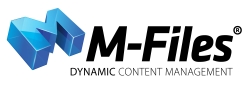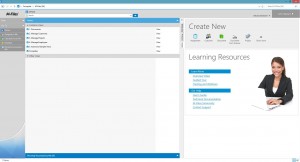A generic ECM provider with AEC expertise, M-Files aims to help organisations wanting the best of both SaaS and on-premise hosting worlds.
Over the past few years I’ve seen various generic enterprise content management (ECM) systems target the architecture, engineering and construction (AEC) sector. When Software-as-a-Service (SaaS – though then known as ASP: application service provision) solutions (4Projects, Asite, Conject, Buzzsaw, e-Builder, etc) were first beginning to establish themselves in the US and UK markets around the start of the century, they were often competing against established electronic document management vendors (eg: Documentum). Solutions such as Open Text Livelink were resold in the UK AEC market by Causeway Technologies, while Microsoft’s SharePoint was sold as an on-premise AEC solution by firms such as Cadac (post).
And – over time – I encountered various purely cloud-based storage solutions which saw the AEC market as an opportunity (eg: Drop.io, Box.net, Vaultium), while employees in many organisations will often bypass corporate solutions and rely on generic cloud storage services such as DropBox, Google Drive or Microsoft’s OneDrive (formerly SkyDrive) – part of a widespread phenomenon sometimes called ‘Shadow IT’ or ‘Stealth IT’ (a December 2013 survey by cloud IT operations specialist 2nd Watch found that 61 percent of US business units bypassed the IT function completely, instead choosing, funding and managing their cloud services on their own – see CIO article; I also wrote about Shadow IT back in February 2008).
Appetite for cloud-based solutions in the AEC sector has clearly grown over this time, but many organisations still prefer to retain their own in-house IT provision. Some vendors have sought to cover both groups, providing ‘hybrid’ suites. The afore-mentioned Causeway, for example, could provide its OpenText-based ECM solution both on-premise or SaaS; Newforma (see recent post) started out as an on-premise server solution but now integrates with a Project Cloud SaaS option; and McLaren Software’s portfolio includes both ECM and SaaS offerings, allowing organisations to make a transition from, say, SaaS use during initial design and project delivery to on-premise applications for operation, maintenance, governance and compliance purposes during the remainder of the project’s life-cycle.
M-Files

 M-Files also seeks to cover both options – like OpenText – by providing a hybrid application, but says it is much more flexible than other solutions. VP of marketing Greg Milliken, right, told me the company – founded in Finland, but now with a US head office in Dallas – has been growing at 50% per annum for seven years. Initially bootstrapped, it closed an investor round in April 2013, and has been looking to expand its presence in various markets including the AEC sector. The company claims it is quite familiar with the AEC market, having created a presentation plotting software solution for AutoCAD users called M-Color that was successfully sold to thousands of AEC customers. M-Files also has a solid base of customers in the AEC sector, including architect Aedas, healthcare architects BSA LifeStructures and Finland-based contractor Fira (see below). This experience gave it a good understanding of the specific ECM needs and requirements of AEC companies, Greg told me.
M-Files also seeks to cover both options – like OpenText – by providing a hybrid application, but says it is much more flexible than other solutions. VP of marketing Greg Milliken, right, told me the company – founded in Finland, but now with a US head office in Dallas – has been growing at 50% per annum for seven years. Initially bootstrapped, it closed an investor round in April 2013, and has been looking to expand its presence in various markets including the AEC sector. The company claims it is quite familiar with the AEC market, having created a presentation plotting software solution for AutoCAD users called M-Color that was successfully sold to thousands of AEC customers. M-Files also has a solid base of customers in the AEC sector, including architect Aedas, healthcare architects BSA LifeStructures and Finland-based contractor Fira (see below). This experience gave it a good understanding of the specific ECM needs and requirements of AEC companies, Greg told me.
The company’s current core ECM solution combines document management, workflow/business process management, image capture and processing, permissions management, records management and collaboration capabilities. In addition, quality management and project management solutions can be built on the M-Files ECM platform to address specific industry and use case needs and requirements. As a result, the application has attracted considerable interest from highly regulated sectors, including life sciences and the oil and gas industry, which require rigorous control of documentation, versions, processes, etc.
 The core of the system is a relational database where all stored items or objects (documents, drawings, forms, invoices, proposals, etc) are managed using a configurable set of metadata fields and associated rules, not folders – so that users find items by searching intuitively for “what” rather than searching folders for “where”. The rules and metadata allow, for example, internally held documents to be shared with external collaborators, and for detailed audit trails of all objects to be maintained. In large projects where many changes are made to numerous documents, high levels of file exchange often occurs between servers as documents are constantly updated.
The core of the system is a relational database where all stored items or objects (documents, drawings, forms, invoices, proposals, etc) are managed using a configurable set of metadata fields and associated rules, not folders – so that users find items by searching intuitively for “what” rather than searching folders for “where”. The rules and metadata allow, for example, internally held documents to be shared with external collaborators, and for detailed audit trails of all objects to be maintained. In large projects where many changes are made to numerous documents, high levels of file exchange often occurs between servers as documents are constantly updated.
However, the M-Files approach reduces the traffic by using ‘differencing’ techniques and replication rules, which dictate that only files that meet specific criteria are exchanged between servers and vaults. In this approach, only a document that has been designated for replication is transferred to the server — and only the changes to the existing document are transmitted, with the new version being created by merging the original and the ‘Delta’ file (although M-Files maintains a complete version history of all documents). (This approach is something I’ve encountered a few times – Graphisoft incorporated it into ArchiCAD 13 in 2009, for example [post], and it remains a feature of Graphisoft’s BIM suite – see Lachmi Khemlani’s recent AECbytes review of BIMcloud).
M-Files at Fira Oy
![]() Finnish construction firm Fira Oy uses M-Files to ensure that development and preparation work advances quickly and that the data produced is documented in real time for use by all stakeholders involved in each project. Anything from 1,000 to 3,000 documents reside in the data bank associated with each project, and approximately 100 different document templates are used in project administration. Looking to replace email-based processes and having evaluated web portal-based systems, SharePoint and expanded use of network folders, it deployed M-Files ECM in 2007.
Finnish construction firm Fira Oy uses M-Files to ensure that development and preparation work advances quickly and that the data produced is documented in real time for use by all stakeholders involved in each project. Anything from 1,000 to 3,000 documents reside in the data bank associated with each project, and approximately 100 different document templates are used in project administration. Looking to replace email-based processes and having evaluated web portal-based systems, SharePoint and expanded use of network folders, it deployed M-Files ECM in 2007.
Fira architects, site managers, vendors and subcontractors all use the same project bank repository within M-Files ensuring that only the most current and up-to-date documentation is used. The firm pre-configured and automated the metadata entry process within M-Files to make it easier and more efficient for its site managers to administer the system while working remotely from construction sites. In 2010, Fira integrated M-Files into its process management software.
With M-Files, Fira architects dictate design changes and then select which other individuals need to review and sign off on the file via the permission management features of M-Files. Once approved, the final design files are merged with cost calculations enabling Fira to immediately provide customers the cost impact of design changes.
M-Files also helps Fira rapidly produce all information needed for compliance purposes (in Finland , auditors can visit worksites at any time to conduct quality assurance evaluations and verify if project documentation is in order), and is being deployed to support areas of HR and IT management, plus BIM (Building Information Modelling).
Hybrid ECM
M-Files can be provided as a 100% on-premise application or a 100% SaaS application “or anything in between”, said Greg. The SaaS component is delivered using Microsoft Azure, in both public and private cloud options – the virtues of cloud-storage include rapid disaster recovery, he continued. It can also be tightly integrated with back-office systems such as ERP and CRM.
Hybrid enterprise content management (ECM) platforms are increasingly popular, allowing organisations to store and access their content both in their networks and in the cloud. Analysts Gartner and Forrester have both predicted rapid growth in adoption of hybrid ECM in 2014; such flexible computing environments allow businesses to maintain their on-premise CRM, ERP and other business applications while integrating hosted solutions to improve and enhance the functionality of their legacy systems. I was told M-Files, according to Forrester, is one of the only providers of a true hybrid ECM application.
The application is complemented by a series of mobile apps (on Apple iOS, Android and Microsoft Windows Mobile), with strong “social” commenting and sharing capabilities similar to those found in Yammer or Jive, Greg said. The cloud-based service starts at $39 per user per month, with the on-premise variant costing $495/seat for a paid-up term license.







2 pings
[…] – or the increasing requirement for ‘hybrid ECM’ (enterprise content management; see post). […]
[…] talked to the company in April 2014 when it outlined its experience in delivering solutions to customers in the architecture, […]